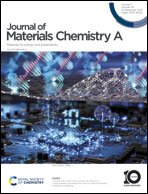A novel 1D/2D core/shell CdS@SnS2 heterostructure for efficient piezocatalytic hydrogen evolution and pollutant degradation†
Abstract
Piezocatalysis attracts extensive attention as a promising approach to energy and environmental problems. However, the high recombination of heat-excited free charges in single component materials seriously restricts the catalytic efficiency. In this study, a CdS@SnS2 composite with a 1D/2D core/shell structure is successfully constructed by a two-step solvothermal method and applied in the piezocatalytic field, exhibiting excellent activity in piezocatalytic water splitting and pollutant degradation. The piezocatalytic performance of the prepared composites is significantly higher than those of the corresponding single components. Through component optimization, the piezocatalytic hydrogen evolution rate and rhodamine B degradation rate of CdS@SnS2 reach 3.7 and 7.4 times those of pure SnS2 and 2.4 and 4.6 times those of pure CdS, respectively. It is demonstrated that the heterojunction built between SnS2 and CdS effectively promotes charge separation, which is responsible for the obvious improvement in the performance of the composite piezocatalysts. Furthermore, the unique 1D/2D core/shell structure not only ensures an intimate and large interfacial contact, but also substantially increases the specific surface area and active sites, which also makes a great contribution to improving the piezocatalytic performance. This work provides a new idea for the design and preparation of heterostructured piezocatalysts.



 Please wait while we load your content...
Please wait while we load your content...